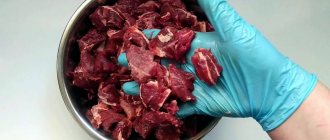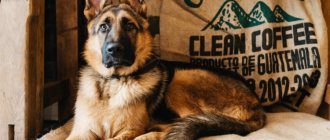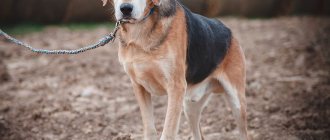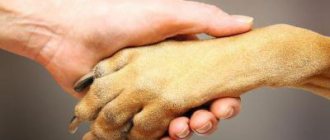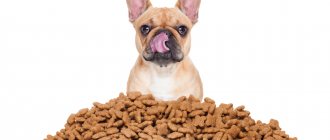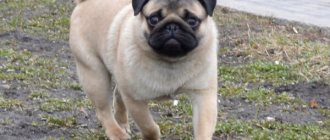Beneficial features
Giblets contain more nutrients than regular meat. Firstly, offal is a source of animal protein, which is a building material for any organism.
Secondly, they are rich in microelements: phosphorus, iron, copper, magnesium, iodine, potassium, zinc, selenium.
Thirdly, these products contain a large amount of B vitamins, folic acid, vitamins A, K, E. In terms of vitamin D content, by-products have no equal among other feeds. This vitamin is one of the most important for living beings. Its deficiency leads to muscular dystrophy, fractures, malignant tumors, rickets, autoimmune, and infectious diseases. Offal is especially useful for dogs living in northern areas with few sunny days. In the cold season, when vitamin D deficiency is most likely, offal is included in the menu.
Fourthly, meat by-products, just like fish, contain healthy fatty acids Omega-3 and Omega-6 - sources of energy for cells.
Giblets contain little fat and carbohydrates, so they can be considered a dietary product.
By-products and muscle meat from animals raised on natural feed are much more nutritious and healthier than those fed on mixed feed.
Lungs, heart, trachea, liver, diaphragm and other tripe are significantly cheaper than meat. By including them in the diet, owners reduce the cost of maintaining a pet.
Acceptable types
Creating a balanced menu for a natural-fed dog is a difficult task, and when introducing tripe, the main thing is not to overdo it. It is impossible to completely replace the meat component of food with tripe without losing the quality of nutrition and without bringing the pet to the dangerous point of an overabundance of various substances, leading to the development of diseases and pathologies of internal organs.
Not all types of tripe are equally useful; some of them will only bring harm. However, the list of good ingredients is quite wide and varied.
Scar
The section of the stomach of herbivores, where the main process of food digestion occurs, is an extremely important element of nutrition for puppies and adult dogs experiencing problems with the digestive system. In addition to the undoubtedly useful vitamins and microelements in fibrous meat, similar in its characteristics to muscles, there are unique bacteria that are ideal for stabilizing and improving the intestinal function of your four-legged friend. That is why the tripe begins to be fed little by little from 5-6 months.
It is important to remember that only the unrefined version will benefit. If the dog refuses to chew the tripe “dirty” because of the specific smell, you can begin to teach it gradually, giving well-washed pieces. It makes no sense to cook, since all the beneficial properties disappear due to the death of bacteria. But if you doubt its safety, you can freeze it for 2 days.
When feeding tripe to pets, a person must follow certain safety precautions, since the bacteria that are beneficial for dogs are very harmful to people. Touch the stomach only with special gloves or wash your hands thoroughly with soap after handling.
Liver
The second most useful and popular organ for dogs is the liver. And this is well deserved. The unique function that the liver performs in the body results in this product being free of toxins yet loaded with vitamin A, which is easily dissolved by fat.
However, liver in large quantities is harmful, as it can cause the formation of stones. In addition, it is considered dietary, which means it is not able to provide the necessary amount of energy for a constant active life.
Veterinarians advise giving beef or poultry liver 1-2 times a week, not more often.
At the same time, liver can be given raw only when purchased from places checked by veterinarians, because it often contains worm larvae. To avoid possible infection, the liver is either frozen or boiled before feeding. Some of the nutritional properties are lost, but the risk of infection is also reduced.
Kidneys
Kidneys help improve the condition of hair and skin, and normalize the functioning of the digestive system. One of the few that can be given raw. The kidney is cut in half, soaked in water and fed.
Heart
The organ consists of powerful muscle tissue, so the heart is often used as a trainer for the jaw muscles and for cleaning plaque from teeth. Also, the positive aspects include the unique composition. This muscle contains enzyme Q10, which slows down aging, and collagen, which is needed for ligaments and joints. Therefore, a heart is necessary for large dogs whose lives involve a lot of physical activity. Feed raw.
Lung
One of the products that has very little benefit. You should avoid adding it to your regular diet. The lungs contain little protein, but there is a lot of connective tissue that is harmful to the digestive system.
If they are introduced into the diet, it is only in combination with other meat elements. But, given that the lung is poorly digested, this is unwise.
How and what to feed your dog
Despite their undoubted benefits, the share of these products in a dog’s diet should not exceed 15%. It is enough to give your dog offal twice a week. You can feed your dog tripe daily, but in small portions.
Liver
This filter organ neutralizes toxins entering the body, but does not store them. Therefore, liver can be safely given to your pet. This product is a source of vitamins A, group B, folic acid, and iron.
Vitamin A is a powerful antioxidant, it improves digestion and has a beneficial effect on the reproductive system. Folic acid and vitamin B12 support the health of the nervous system, improve brain and vascular function. Iron increases endurance, participates in the formation of hemoglobin, brain functioning, metabolism, and saturation of cells with oxygen.
The liver is especially useful for rapidly growing young dogs, as well as for preparing breeding dogs for mating and for feeding lactating bitches.
When exposed to high or low temperatures, the nutrient content decreases, so it is preferable to feed dogs raw liver. However, sometimes worm larvae are found in it. To avoid infection, the liver is either boiled or frozen. This product can be fed to animals in its raw form only after a veterinary check.
The share of liver in the diet should not exceed 5%. Exceeding the dosage leads to digestive disorders.
Lung
This organ contains a significant amount of connective tissue, has low calorie content, small amounts of protein and is poorly digested. The lungs do not bring significant benefits to the dog's body. To avoid vomiting, they are introduced into the diet gradually, boiled and crushed. It is better to combine lungs with other offal.
Heart
This is a source of antioxidant and immunomodulator coenzyme Q10, which is necessary for cell activity and inhibits the aging process. The organ contains selenium, zinc, phosphorus, as well as B vitamins and amino acids, which help build muscle mass, produce and store energy, and increase endurance.
Heart contains twice as much collagen and elastin as regular meat, which is important for joint health. It is similar in structure to muscle meat, but heavier and denser. Dogs are safely fed raw hearts.
Is it possible to feed raw meat?
It has been proven that eating raw meat is more valuable for a dog's health, since its nutritional value is higher than that of cooked foods. However, if you want to feed your pet offal, some of them must be boiled - for example, kidneys.
Before giving them to the dog, they are soaked in salted water for several hours and then boiled. Beef lung can also be given to your dog raw.
To feed your dog liver, you need to know that beef offal can be given raw, since beef does not carry the risk of helminthiasis, and pork liver can only be given boiled, since raw offal may contain helminth cysts.
Chicken from a home farm, raised without the use of antibiotics and hormonal additives, can be given to a dog raw, and if you bought poultry meat from a poultry farm, then before giving the product to your pet, be sure to boil it.
Chicken heads, necks and skin should not be given to dogs as food, either raw or cooked.
Beef ribs or cartilage can be given to the dog raw, and if they belonged to wild animals, they must be boiled so as not to infect the dog with infectious diseases. Products made from beef, lamb, and horse meat are considered safe, as they undergo strict veterinary control, while meat from wild animals carries the threat of disease.
Poultry by-products
The liver, heart, stomachs, necks of birds, as well as their bones, heads, paws are inexpensive, healthy and nutritious food. These products rarely cause allergies. They are especially valuable for their high content of collagen (in necks and wings) and protein (in heads and paws).
Although poultry by-products are not as healthy as beef by-products, they are an excellent and healthy addition to your dog's diet. Giblets of chickens, turkeys, and ducks are gradually introduced into the diet of puppies, adding little by little to the main menu and observing the reaction of the digestive tract.
Chicken heads
This is a source of calcium and a real treat for those who like to chew. In order not to injure the esophagus and stomach, the bird’s beak is removed and the head itself is broken. Dogs are fed boiled heads.
Liver, heart, stomach
Chicken or duck liver is a source of vitamins A and B12, the stomach and heart are rich in protein, zinc, iron, collagen and elastin. These giblets are given to dogs no more than 2-3 times a week, because with an excess of vitamin A, muscle mass decreases and bones become deformed.
Can I give my dog raw beef lung?
Lungs are popular among offal products due to the fact that they contain a vitamin complex that is beneficial for the respiratory system of dogs. These substances are especially important for animals leading an active lifestyle. The lungs contain a lot of protein, which has a positive effect on the growth and functioning of the body. Some dog breeders use this product as a reward during training.
Note! A dog's diet should include lungs no more than 2 times a week. It is recommended to mix the offal with rice porridge.
Lungs are waste products and rarely undergo additional testing before sale. Therefore, it is not recommended to give the product raw. The meat may contain larvae of various parasites. Before giving the lungs to your pet, they should be thoroughly boiled.
In addition to parasites, the danger is posed by connective tissue, which in its raw form is poorly digested and causes diarrhea and vomiting.
Selection and storage
Dogs are fed only fresh offal obtained from healthy animals and not showing signs of spoilage. Puppies begin to accustom themselves to this type of food at 5-6 months, with the exception of udders and chicken necks, which are indicated at 2-3 months. Younger children are fed broth or jellied meat made from offal. Brains, udders, spleen, lungs and kidneys are not given to pets with sensitive digestion.
Raw offal is included in the animal menu only after a veterinary inspection. Otherwise, they must be boiled or frozen. Boiled offal and minced meat are not as healthy as raw meat, but in this case the dog will not develop diarrhea, vomiting or more serious infectious diseases. If there is any doubt about the freshness of the products, they are kept for 20-30 minutes in a baking soda solution, then rinsed thoroughly.
Damaged brains and spleens are especially dangerous for dogs. Signs of brain damage are a creamy consistency, an unpleasant odor, and a dark earthy color. A stale spleen darkens when cut.
How long to cook?
To ensure that the meat is safe for dogs to eat, it is boiled. You cannot use salt or any spices for this process . Any extraneous additives and flavor enhancers negatively affect the quality of the finished product, which, when eaten, affects not only the dog’s liver and stomach, but also his sense of smell.
During cooking, a piece of meat decreases in size by about three times, becoming denser. In this case, a very large part of the protein passes from the meat into the broth, and all valuable amino acids and vitamins in the product are destroyed.
When cooked, the nutritional value of a meat product is significantly reduced, which means that the dog’s portion of finished boiled meat needs to be increased. As a rule, in order to provide the pet with complete satiety, a piece of boiled meat should be 3 times larger than a piece of boiled meat.
The cooking time should be such that the piece of meat is completely cooked inside and out. Cooking time directly depends on the type of meat and the size of the piece and is usually at least 20-30 minutes. Ready-made broth is usually not given to the dog, since the concentration of substances in it, boiled and
Possible reactions
Some pets cannot tolerate offal and entrails even in small quantities. Food intolerance to offal is manifested by vomiting, diarrhea, irritation on the skin of the face, paws, ears, front legs, armpits, and around the anus. Sometimes skin or ear infections, red spots, hair loss, and constant scratching occur. There is no point in treating food allergies; it is enough to exclude allergens from the diet - chicken or meat by-products.
Benefits for dogs
Not all owners know whether it is possible to feed their dog offal.
Heart as a product has the following effects on the body:
saturates with vitamins, microelements, minerals, which normalizes metabolism and eliminates hypovitaminosis;- replenishes strength and energy;
- normalizes the functioning of the digestive tract;
- strengthens dental and muscle tissue, bones, joints;
- prevents the development of osteoarthritis, osteoporosis;
- accelerates the growth of muscle tissue;
- increases endurance.
The product is useful not only for physical health, but also mental health.
Regular consumption of food improves the dog’s behavior, while:
the nervous system is stabilized, which is facilitated by zinc, phosphorus, copper contained in the heart;- Aggression and irritability decrease;
- the condition of the cardiovascular and nervous systems improves, and the dog’s behavior during training is normalized.
The positive effect is achieved by introducing an adequate portion of cardiac tissue into the diet.
Reviews
Gennady, Moscow
“I give my Yorkie chicken or turkey necks not so much for food, but for entertainment, to chew on instead of a bone. 4-5 pieces at a time, of course, not every day. Also chicken gizzards and heart. I also occasionally indulge in beef liver. Toda is ready to give everything for her.”
Tatiana, Volgograd
“The dachshund regurgitates the kaltyk back, the rest - the heart, lung, tripe - eats perfectly. I make small crackers from chicken liver: boil them, dry them in the oven, then cut them into cubes. An ideal treat for training."
Can it be given raw?
A medium or large dog without diseases of the digestive system is allowed to give the product without boiling it.
The component is introduced into the menu gradually so that diarrhea or vomiting does not occur. Recommended to combine with cereals, liver, and vegetables. But the owner must not forget that the total portion of offal at one time should not exceed 15-20% of the entire meal.
Small breeds should not be given raw heart: their digestive system cannot cope with such a load.
Feed with by-products
To compensate for the lack of vitamins and microelements, veterinarians advise using feed containing by-products.
The positive side of this method is the exclusion of hypovitaminosis. With the help of dry food, animals receive all the useful substances that replenish their daily requirements.
The disadvantage of dry food is the lack of variety in the diet. Many dogs get bored with this type of food, so they refuse to eat.
Rules for choosing dry food with a heart
When the packaging states that the composition contains dried heart fibers, this is not always true.
The owner needs to carefully read the composition. It must contain a direct indication of the presence of components.
It is recommended not to purchase goods with the following information:
- meat and bone meal;
- a large number of by-products.
The occurrence of dyspeptic disorders and other reactions are signals to stop feeding.
Rules for introduction to nutrition
By-products should not be introduced in excessive portions, immediately. This process is carried out according to the following rules:
- To start feeding offal, the puppy must be at least 6 months old;
- removed in small pieces so that the digestive tract has time to get used to the food;
- gradually increase the dose corresponding to the age and weight of the dog;
- the heart is given in large quantities 2 times a week, or in small portions daily.
If these rules are followed, gastrointestinal dysfunction will not occur. The total amount of daily ration should not exceed 15% of the entire food portion .
Correct heat treatment
It is recommended to boil for no more than 30 minutes to preserve the beneficial components.
Industrial feed
In the composition of industrial dry food, the presence of by-products is often listed first. Before purchasing such a pack, you should know about some of the features of using this ingredient on an industrial scale.
Firstly, it should not come first, since tripe is not as nutritious as meat, which means the food will not have enough calories and will not be able to provide the necessary energy for an active life.
Secondly, dry food contains organs that are unsuitable for human food. That is, this is tripe that has not been frozen for more than a day since the carcasses were cut up. It is no longer suitable for people, but for dogs after appropriate processing, drying and grinding it will be completely healthy and will not cause any harm.
